How To Close Rolfix Bellows Camera
Posted xi-xvi-02
This camera manual library is for reference
and historical purposes, all rights reserved.
This page is copyright past "![]() " Thou. Butkus, NJ.
" Thou. Butkus, NJ.
This folio may not exist sold or distributed without
the expressed permission of the producer.
I have no connection with whatever camera company.
On-line camera manual library
If y'all find this transmission useful, how most a donation of $iii to:
M. Butkus, 29 Lake Ave., High Bridge, NJ 08829-1701
and ship your email address then I tin thank you.
Most other places would charge you $seven.50 for a electronic re-create
or $18.00 for a difficult to read Xerox re-create.
buy new manuals, and pay their shipping costs.
It'll make you lot feel better, won't it?
If you use Pay Pal, use the link beneath.
Use the above accost for a check, M.O. or cash.
Back to main camera manual folio
CLICK Hither FOR Rolifix PDF VERSION

Rolfix Parts
 | 1. Opening Push button (dorsum) 2. Moving-picture show Winding Knob 3. Opening Button (front end) 4. Platform v. Platform Struts 6. Lens 7. Shutter Release 8. Viewfinder |
AN D CONTROLS
 | i. Lens |
| i. Lens two. Footage Focus Scale 3. Lens Opening Scale 4. Shutter Speed Calibration 5. Shutter Winding Lever 6. Cocky Timer seven. Flash Connector 8. Cable Release Socket 9. Yard-X Flash Synchronizer Settings 10. Grand Flash Exposure Setting (on self timer) | |
| ane. Lens |
SPREAD OUT THIS DOUBLE PAGE
AND HAVE THE CONTROLS OF YOUR ROLFIX VISIBLE
WHILE You lot READ THIS BOOK
Information technology is easy to take pictures, day or night, with your ROLFIX folding photographic camera. Beautifully designed and:-constructed, your ROLFIX has a top. quality coated lens and a shutter that is internally synchronized for flash exposures. Learn to operate your ROLFIX so as to get maximum enjoyment: of the precision workmanship and performance of this fine German camera.
Utilize only standard blackness and white or colour coil motion-picture show size No. 1 20.
The ROLFIX is equipped to take two dissimilar sizes of pictures. You will get the following number of pictures with these No. 120 films: - -
| Black and White films | 8 exposures, size 2 1/4" x 3 1/4" 12 exposures, size two'/4" x two 1/four" |
| Ansco and Extachrome Color films | half-dozen exposures, size 2 one/4''x iii 1/4" 9 exposures, size 2 i/iv" x ii ane/four" |
| Kodacolor films | 8 exposures size 2 i/iv''x 3 i/4" |
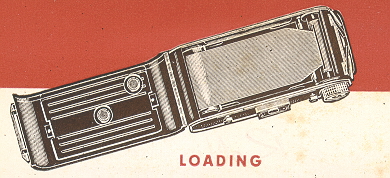
The directions for loading are included in this part of the text as the starting time stride in the motion-picture show taking routine as a whole. Nonetheless, we recommend that you read this volume through and larn the complete operation of your ROLFIX before actually loading the camera with film.
1. Open up the back of the camera by pushing the opening button (back) in the direction of the arrow. Inside you volition discover a removable metal frame. This is a moving-picture show mask which, if left in place , will give you 12 pictures, size 2 l/4''ten 2 one/4''. Use the upper flick window for keeping track of exposures: If you desire total size two 1/4 x 3 1/four" pictures, remove this picture mask-entirely and use the lower film window for counting exposures. :
2. You volition find an empty spool at the winding knob end of the ROLFIX. Leave it in its chamber. information technology is on this take-upwardly spool that the film is wound. Insert the new roll of picture show into the other motion-picture show chamber.
iii. Suspension the seal and pull the motion-picture show across the camera back. toward the empty spool, making sure that the blackness side of the paper faces downwards. Insert the narrowed end of the paper into the longest slot of the empty take-up spool. Give the winding knob ane turn to securely appoint the moving picture, making certain the film is running straight across the camera back
iv. Close the camera dorsum. Button the moving-picture show window button on the dorsum of the camera upward to uncover the windows. Now wind the motion picture by turning the winding knob in the direction of the arrow until the number "ane" appears in whichever film window corresponds with the size picture y'all are taking. (Upper window, 2 1/4" x 2 ane/4" lower window, 2 1/4" x 3 1/four.). Close the windows once again by sliding the button down. NOTE: To protect the motion picture from light and possible fogging go on windows covered except when winding film.
ALWAYS LOAD Photographic camera IN SUBDUED Light.
OPENING THE Forepart
To open up the ROLFIX, printing the opening push button (front). The forepart platform volition spring open up. Pull the platform down until both struts take hold of and click. (To shut, printing down on the struts and push platform in until it clicks shut.)
FOCUSING
The accuracy with which y'all focus depends upon your ability to guess distances. Information technology is best to fix a "yardstick", such as 1 walking footstep equals near three feet. When y'all take judged your camera-to-subject distance in feet,
turn the lens until the indicator- is opposite the desired number on the footage focus scale. When taking distance pictures (beyond fifty feet) prepare the lens at "Infinity" (no) to reach universal focus. NOTE: It is best to set the lens at "Infinity" before closing the camera. Otherwise the lens wilt protrude and may be damaged every bit you lot close the camera.
LENS OPENINGS
The size of the lens opening regulates the corporeality of low-cal which reaches the movie. Set the size of the lens opening by. moving the lens opening indicator to the desired number on the engraved lens opening scale. NOTE: fi22 or f/32 is the smallest lens opening; fi3.5 or f/4.five is the largest lens opening; therefore, the everyman numbers on the lens opening calibration allow the greatest amount of light to. reach the film during exposure.
DEPTH OF FIELD
When the footage focus scale is set for a given photographic camera to-subject altitude, the ROLFIX will focus sharply upon any object at that distance. Objects closer to or farther from the photographic camera are acceptably sharp. The depth of this secondary zone, that of acceptably sharp focus, is called the Depth of Field. Note: The Depth of Field zone increases as the lens opening becomes smaller, that is, equally the lens opening indicator is moved toward the highest numbers on the scale. (See Depth of Field Guide, page 19.)
DEPTH OF FOCUS Adjustment Ring
ROLFIX and ROLFIX 2. On the forepart of the shutter there is the ring for adjusting the depth of focus means of which the effective depth of focus may be ascertained:
To LEFT and Right of the indicator are the diaphragm values in the same order from iii.v resp. 4.v through 22.
Underneath information technology is the distance-setting ring with numbers in anxiety. The depth of focus is thus limited by the indicated anxiety under the diaphragm value on the left and the feet indicated under the equal diaphragm value on the correct. Patently the values of depth of focus volition modify with any alteration in the setting of the lens.
SHUTTER SPEEDS
The shutter speed scales of the ROLFIX cameras are marked as follows:
Rolfix Junior... Bulb, 25, l, 200
Rolfix..............Bulb, 1, 2, v, 10, 25, 50, 100, 250
Rolfix II .........Bulb, 1, 2, 5, 10, 25, fifty, 100, 250, 500
These markings designate one 2d or the partial part of a second the lens volition remain open up when the shutter has been released. Set the shutter speed by turning the large collar on which the speed scale is engraved until the desired number is opposite the pointer.
Time EXPOSURE SHUTTER SETTINGS
Rolfix Junior.... When the shutter is fix at "B" (Seedling), it will remain open every bit long as the shutter release is being pressed and will close when pressu're is lifted. Use "B" for any exposure requiring a longer time (slower shutter speed) than is marked on the shutter speed scale. Open wink pictures may exist taken on "B" setting.
Rolfix Use "B" every bit directed in a higher place. When the shutter is set at "B" (Seedling), it volition remain open after release, every bit long as the release is being pressed.
Rolfix Two Utilise "B" as directed above. "T" Time Exposures. For long exposures, when taking pictures at nighttime, of interiors, with insufficient illumination, or operating with flashlight powder etc., a wire release with adjusting spiral is used, which is mounted in the wire release socket of the shutters Set shutter on "B", press wire release and tighten adjusting screw. The shutter volition stay open as long equally the adjusting-spiral is not loosened again. These long exposures can be made only with a tripod or-some other firm and steady support.
Note: Always apply a tripod or other firm support when taking pictures with slower shutter speeds than i/25th 2nd.
OUTDOOR EXPOSURE GUIDE
FOR VERICHRO ME, PLENACHROME, SENSACH ROME, PLUS Ten AND SUPREME FILMS
(Under ordinary light conditions with black and white moving picture, the boilerplate camera setting is f/11 at fifty/50th second or f/16 at l/25th 2nd.)
For faster films (Super XX, Superpan Printing, etc.) use the next smaller lens opening (side by side higher number).

For color films use the next larger lens opening (next lower number). For brilliantly lighted subjects utilise the side by side smaller lens opening; for close-ups and pictures in the shade use the next one or 2 larger lens openings.
SHUTTER RELEASE
The ROLFIX cameras are equipped with a shutter winding lever which prevents double exposures. The shutter release will work only if this lever is pushed to the left, or wound.
Release the shutter by pressing the shutter release push button. NOTE: Use a dull steady pressure on the release button to avoid moving or jerking the camera and thereby blurring the movie.
The Roltix Junior and Rolfix have a shutter cable release socket. A cable release is used primarily for remote control release of the shutter or for extremely long exposures. Any standard cable release with tapered threads (# 5) will fit the socket.
Cocky TIMER
(DELAYED SHUTTER ACTION)
A self timer release is built into the shutter mechanism of the ROLFIX. This timer delays shutter action after the release button has been pressed, enabling the person who is taking the picture to exist in the picture as well. When using the self timer, place the photographic camera on a tripod or other firm support. Operate the cocky timers equally follows:
Rolfix .... Make the proper distance, Shutter and lens adjustments. So push the self timer lever down and to the left as- far as it volition get. Wind the shutter, press the shutter release and get into the picture. You will have approximately 10 seconds in which to go into the picture earlier the shutter is actually released and the picture snapped. Annotation: The cocky timer tin can be used for whatever shutter speed except Bulb.
Rolfix Ii .... Make the proper distance, shutter and lens adjustments. Push the shutter winding lever to the right until it winds. Push button the self timer button back, then push the shutter winding lever on over to the correct as far equally it will become. Press the shutter release and become into the flick. You will have approximately 10 seconds. Note: The self timer can be used for any shutter speed except Seedling and 1/500 sec.
DOUBLE EXPOSURE PREVENTION
The Rolfix xi (Deluxe) is furnished with a catch preventing double exposures.
After each exposure the shutter release is locked; therefore do not apply force. The take hold of is opened only by winding the picture to the next number. The cerise signal abreast the shutter release indicates that the catch is removed and the camera ready for the next picture show.
Attention! When handling the photographic camera without a film, mind that after the appearance of the reddish signal you must give the film winding knob one more than turn. This is not the case with the picture show installed, for and so you e'er wind as far every bit the next number.
Motion-picture show RECORDING Deejay
As a means of recording what picture show is loaded in the camera, there is a film record deejay mounted on the film winding knob.
| Rating | |
| Case: Super Xx Film | 100 |
| Kodachrome | 10 |
| Kodacolor | 25 |
After the camera is loaded, plow the disk until the index marker points to the proper film speed. The outer ring is set for DIN ratings and the inner ring for ASA ratings.
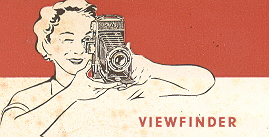
The Rolfix jr (Deluxe) is equipped with a telescop viewfinder. Aim the photographic camera by looking through the small foursquare of the finder and "framing" your moving-picture show in the big square. If taking 12 pictures size 2 one/4" ten 2 1/4'', employ the smaller frame which is limited by the inner straps. On the pinnacle of the finder at that place is a holder for accessories.
The Rolfix (Deluxe) and Rolfix Two (Deluxe) are furnished with a new finder torso with telescope-finder and adjustable window. Aim the camera by looking through the small square of the finder and "framing" your picture in the large square. If taking 12 pictures 2 ane/4"x2 1/4" push the button on top in management of pointer to the indicated size. On the top of the finder there is a holder for accessories. What you tin see through the frame of the viewfinder will exist the movie.
If the subject to be photographed is vertical, hold the ROLFIX upright with the finder on the correct hand side. Hold the photographic camera firmly in both hands, cradling the platform in the palm of the right hand and so that the shutter release can be pressed with the thumb of the right hand. If the field of study is horizontal, hold the photographic camera on its side with the viewfinder at the top, however cradling the platform in the palm of the right paw, but and so that the shutter release can be pressed with the index finger.
With the camera in either position, put your eye very shut to the viewfinder and hold the photographic camera straight and steady against your face while aiming through the finder and pressing shutter release.
TAKING THE PICTURE
It is best to practice the post-obit picture-taking routine before actually loading your ROLFIX with film. In this way y'all tin can become familiar with the ROLFIX controls and avoid forgotten details.
1. Select your subject. Carefully gauge the camera-to-subject distance and focus the camera lens by setting the footage focus indicator.
2. Ready the shutter speed and lens opening equally indicated by the exposure guide in this book, a calculator or calorie-free meter.
3. WIND THE SHUTTER!
iv. Aim the camera accurately, making sure all of your subject is in the viewfinder. Have your moving picture well-counterbalanced co-ordinate to the size and shape of the finished motion picture desired. (Vertical, horizontal, amount of groundwork, etc.)
5. Hold the camera every bit directed previously, keeping information technology level and steady against your face. (or waist.)
six. Printing the shutter release slowly and steadily, trying non to jerk the camera.
7. Wind the film immediately after taking each picture, being careful to use the right film window.
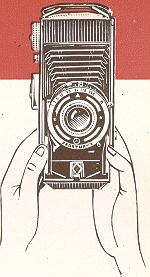 | CLOSING THE FRONT It is best to go along the front of the ROLFIX closed at all times except while actually adjusting the camera-setting or taking pictures. Carrying the camera with the front platform open up endangers the entire working. machinery and lens to bumps and scratches. Larn to operate the camera quickly, so that you will not be tempted to keep the platform open in order to take a "fast" snapshot. Earlier endmost your ROLFIX, remember to plough the front lens back to "Infinity". Do not close the camera while the shutter and self timer are wound. To close the ROLFIX, press downward on the struts and button the platform in until it clicks shut. |
REMOVING THE FILM
Later on the last picture has been taken, wind the film until you can no longer come across the paper through the film window. Then open the dorsum of the camera and current of air the moving-picture show up tight on the spool. Fold the pointed end of the film paper under and seal the spool with the "Exposed" sticker. Remove the exposed roll by pulling out the film winding knob and lifting the curl out of its chamber.
Transfer the empty spool from the picture show supply chamber to the take-up chamber so as to be ready for the next roll of film.
FLASH PICTURES
The ROLFIX cameras have born synchronization for flash; that is, a special switch in the shutter which automatically fires the flash bulb when the shutter is released. With built-in flash synchronization a battery holder and reflector with the proper connecting cord are all that is necessary. Use the European type (sometimes called the "Prontor Southward") connecting string.
Specific instructions for wink are every bit follows:
Rolfix Inferior (Vario Shutter) .... Use just midget flash bulbs (SM or SF). Set up shutter speed at 1/50th for all flash exposures. See Flash Exposure Guide, folio 18, for right distance and lens opening settings.
Rolfix (Prontor M-X Shutter) .... The Rolfix shutter is equipped with settings for 2 flash synchronization contacts: M Contact (yellow dot) and Ten Contact (blood-red dot).
M Contact .... Fix M-Ten indicator at G. Use any class M (wire-filled) flash bulb (# five, 25, 11, 22, 0, 40). Use any shutter speed. SET Cocky TIMER AT M. (This self timer M setting is necessary, as it compensates for the delay between release of shutter and pinnacle of flash.) Meet Flash Exposure Guide for correct · distance, shutter speed and lens settings. NOTE: M flash synchronization is most commonly used because it operates at any shutter speed and accommodates bulbs with greater calorie-free output.
X Contact .... Set Thou-Ten indicator at X. Use any grade F (gas-filled) bulb (SM or SF). Set shutter speed at 1/50th or slower. Meet Flash Exposure Guide, page 18 for correct distance and lens settings. NOTE: Use 10 synchronization when taking self timing pictures. An electronic strob gun may be used with X synchronization. With strobe gun use any shutter speed.
Roltix Two (Synchro Compur-Rapid Shutter) .... The Rolfix Ii, like the Rolfix, is equipped with M-X wink synchronizer contacts. See instructions for the Rolfix, above, for operation of the M-X synchronizations, with this exception:
1000 Contact .... Set 1000-X indicator at Yard, just Do NOT WIND THE Self TIMER. (The timer that compensates for the delay betwixt shutter release and peak of flash is built into the shutter of the Rolfix 2 and therefore sets automatically.)
FLASH EXPOSURE GUIDE
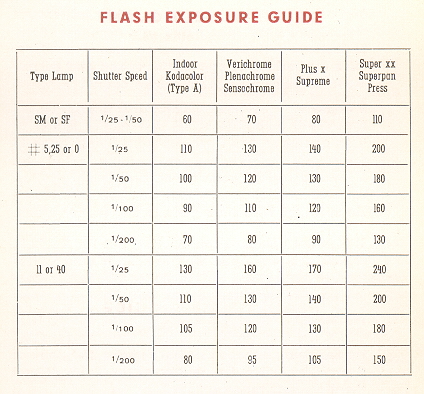
How to employ the above guide: For example, the guide number for A # 5 bulb using Verichrome film and '/2sth shutter speed is 130. If the camera-to-bailiwick altitude is 10 anxiety, divide 130 by x, which is 13. Apply the f stop closest to xiii, or in this case f/11. For additional data run across the exterior of your flash lamp carton.
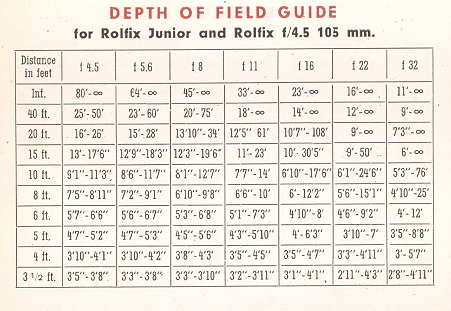
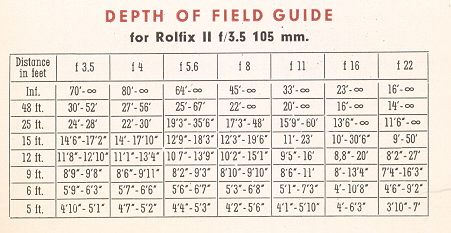
HINTS FOR BETTER PICTURES
1. Ever keep the camera lens clean. Use only very soft lens tissue when cleaning to avoid scratching the lens.
2. Always load and unload your camera in subdued light NEVER IN Directly SUNLIGHT.
iii. Learn and adopt the correct picture-taking routine. (Run into page 14.)
4. Do not take a picture directly into the sun.
5. Focus accurately. Pace off the distance. (1 step equals well-nigh three feet.) The minimum camera-to-subject distance for sharp focus is about four anxiety, unless yous use a special portrait lens
vi. Guess light conditions carefully. Utilise an exposure table, a meter or calculator whenever possible. If in incertitude, tend to over-expose.
seven. For photographing a subject in move utilise a faster shutter speed (almost l/100th second) or cull a photographic camera position so that subject movement will exist toward or away from the photographic camera.
8. Hold the camera level and steady when pressing the shutter release. Always use a tripod or other firm support when taking pictures at a slower shutter speed than 1/100th second.
nine. Wind the picture show afterward each picture.
10. Keep the moving-picture show windows closed except when winding movie.
11. Do non use exceptionally one-time flick. Information technology is all-time to have picture adult before the expiration date.marked on the box.
CARE OF YOUR ROLFIX
The front end and rear elements of your ROLFIX lens should be carefully cleaned from time to time with soft lens tissue or a camel's hair brush. If dust particles accumulate within the camera, blow them out carefully. Protect your camera from sand, snow and rain.
REPAIR AND REPLACEMENT
To obtain service on your ROLFIX contact your nearest Wards Retail Store, Mail Order Firm or Itemize Office. Provide the Model Number of the camera.
Source: https://www.butkus.org/chinon/rolfix/rolifix.htm
Posted by: wilbankssmill1985.blogspot.com

0 Response to "How To Close Rolfix Bellows Camera"
Post a Comment